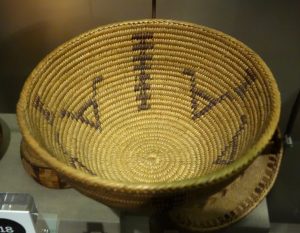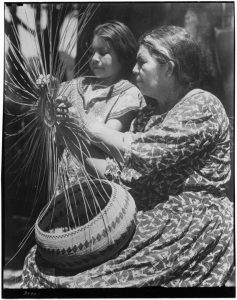Pomo basketry is famous for its intricate designs and fine craftsmanship. People were often buried with their baskets or with baskets which had been made for them. Annie Burke, an exceptional Pomo basket maker, lamented what she saw as the end of the cultural knowledge and tradition of basket weaving at the turn of the 20th century and asked her daughter, Elsie Allen, to collect and exhibit her baskets instead of burying them with her. Annie Burke and Elsie Allen worked hard to keep Pomo basketry alive; Allen was forcibly removed from her home at 11 to live in a boarding school but as a young adult she reconnected with basketry and taught both Pomo and non-Pomo some of her mother’s cultural knowledge.
When I was poking around for Miwok artifacts I kept stumbling on Pomo baskets. Coast Miwok and Southern Pomo are so close, geographically, it would make sense that they both made similar baskets–or that they traded baskets for other goods. After finding reference after reference to Annie Burke and Elsie Allen I wondered if the reason why it’s so much easier to find examples of Pomo basketry is because it had a spokesperson and protector who was successful in keeping the cultural knowledge of basketry alive. Perhaps without an Elsie Allen, Coast Miwok baskets have largely been lost.
This is an example of a Coast Miwok basket from the Oakland Museum of California. It is similar to Pomo baskets, but maybe a little less refined.


Annie Burke teaching basket weaving, 1935